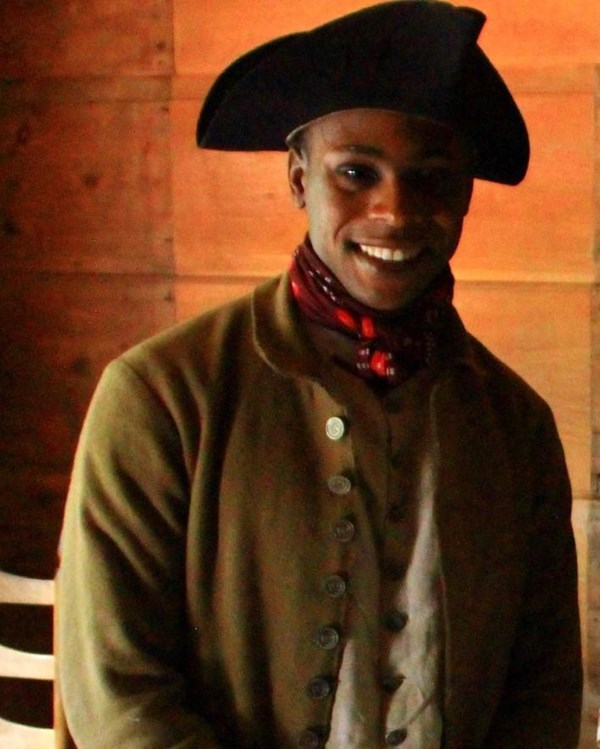Last updated: February 25, 2025
Person
Cato Smith: Enlisted and Enslaved?

NPS photo
In April of 1775, as thousands of white colonists were taking up arms to defend life, liberty and property, other men, denied the blessings of all three, were marching with them. Cato Smith was one such man. Though you could argue his life was his own, his body legally belonged to someone else. Liberty for him was a dream; and far from owning property to defend, he was himself considered property. Cato Smith was one of the thousands of enslaved Africans who lived in Massachusetts at the time of the American Revolution.
His home was along the Bay Road within the town of Lincoln. The house itself was built in 1693 and is today preserved as part of Minute Man National Historical Park. In 1775 it was home to the Smith family. The family consisted of William and Catherine Louisa, and their children Elizabeth, Louisa Catherine and William Jr., all under the age of 4. Cato was enslaved to this family.
Cato was born in Africa. At age 10 he was taken onboard a slave ship in Ghana and brought to Boston to be sold. Once in Boston he was purchased by Rev. William Smith of Weymouth MA. 10 years later, in 1771, Rev. William Smith gave 20 year old Cato to his son, William who would later reside in the old house in Lincoln.
On April 19, 1775 William Smith was captain of the Lincoln minute man company. This company answered the alarm and fought at Concord’s North Bridge and joined the pursuit of the regulars back toward Boston. There is no record of Cato turning out to fight that day. However, 5 days later, April 24th, Cato enlisted as a soldier in William Smith’s newly raised company in the 6th Massachusetts Regiment commanded by Colonel John Nixon.
Why this was done is hard to say. Whether or not Cato wanted to serve as a soldier the decision was obviously William’s. One possible reason could be that William needed to fill his ranks in order for his new company to be accepted. It could also be that William, like so many others at the time, feared the enslaved people would take advantage of the situation and rebel. By enlisting him William would thus remove a possible threat to his own family. Even in the tight-knit communities of colonial Massachusetts the relationship between enslaved people and their enslavers was tense.
Cato served in the Massachusetts Army at Cambridge until the end of 1775. Then, in the late summer of 1776, with the theater of war focused around New York, Cato enlisted again; this time possibly as a substitute for William. He served as a soldier in the 4th Massachusetts Regiment and saw action at Long Island, Manhattan, White Plains, and Princeton. The long and difficult campaign must have taken a heavy toll on Cato. He died in camp at New Castle NY January 23, 1777.
It is often assumed that enslaved men pursued military service as a pathway to emancipation. In most cases it was but not always. It is unclear whether Cato was still enslaved during his military service. Though when alive he collected his own pay, after his death William received his back-owed wages. What is clear however is that whether enslaved for free, Cato served and died as a soldier in the Continental Army. He was one of 2,100 men of color from Massachusetts who served in the military during the American Revolution.
Learn more about the military service of African and Native Americans in the Revolution!
Bibliography
Hafner, Donald William Smith, Captain: Life and Death of a Soldier of the American Revolution, Lincoln Historical Society, Lincoln MA 2017
Wright, Robert K. Jr. The Continental Army, Center of Military History, United States Army, Washington DC, 2000
Commonwealth of Massachusetts, Massachusetts Soldiers and Sailors of the Revolutionary War, Wright & Potter Printing, Boston MA 1896
Hannigan, John, “How many men of color from Massachusetts fought in the American Revolution? How many were free? How many were enslaved?” Unpublished paper written for Minute Man National Historical Park, 2014 https://www.nps.gov/mima/upload/PoC-Paper-1-Final-Version-for-Website.pdf
The following is from the 2004 National Park Service study Patriots of Color researched and prepared by George Quintal:
Nothing is known of the early life of Cato Smith.I
He joined the eight month’s service on 24 April 1775 from Lincoln (MA), in the company of Capt. William Smith in Col. John Nixon’s regiment. His name appears on a 26 June 1775 receipt for advanced pay, on the 1 August 1775 roll and on a 30 September 1775 company return.II
In 1776, he enlisted in the company of Capt. Joseph Butler in Lt. Thomas Nixon's 4th regiment. This unit served at the Battle of White Plains. Rolls from September through November place him at North Castle (NY). He died in the service on 23 January 1777.
Footnotes:
I. Soldier description unavailable – soldier placed in database based on given (first) name alone.
II. Secretary of Commonwealth. Massachusetts Soldiers and Sailors of the Revolutionary War (1896-1908), 14:358. Also 2-CD Family Tree MakerTM set “Military Records: Revolutionary War.”
